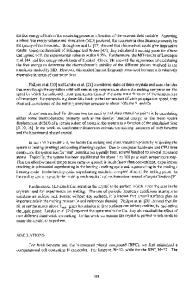Capture carcinogenic aromatic compounds by the design of new tweezer compounds: a theoretical study
- PDF / 1,279,212 Bytes
- 6 Pages / 595.276 x 790.866 pts Page_size
- 52 Downloads / 332 Views
ORIGINAL PAPER
Capture carcinogenic aromatic compounds by the design of new tweezer compounds: a theoretical study Ali Abdullah Issa 1 & Hasan R. Obayes 1 Received: 2 August 2020 / Accepted: 21 September 2020 # Springer-Verlag GmbH Germany, part of Springer Nature 2020
Abstract Both [5]-circulene and [7]-circulene can be selected to design the molecular tweezers theoretically using the DFT method. Leaning on the cyclic polymerization mechanism, we obtain four new tweezer compounds. Theoretical results offer that tweezer compound (I) is additionally stable than other compounds because it has better energies than other compounds. The values were as follows: − 2606.83372937 a.u. for the total energy, − 5.39820 eV for (EHOMO), and 2.87407 eV for gap energy. The thermodynamic theoretical outcome showed that all reactions are exothermic and spontaneous, suggesting that tweezer compound (I) might correlate with several aromatic compounds, such as pyrene, benzo[ghi]perylene, ovalene, and hexabenzocoronene. The correlation energy results showed an increase as the aromatic compound becomes larger, while the correlation distance decreases. All correlation energy kinds are electrostatic. The value of the electrostatic correlation energy of tweezer compound (I)-ovalene is (− 6.4928615 kJ mol−1). The tweezer compound (I) has a spherical cavity equal to 3.73640 nm3, which adds an important application in the ability to capture chemicals, bacteria, or viruses that are close to the size of the cavity with ease. Keywords Tweezer compound . DFT . Correlation energy . Design . Electrostatic . Aromatic compounds
Introduction The expression “molecular tweezers” was first applied by Whitlock [1]. Molecular tweezers at times called molecular catchers are host molecules with open cavities capable of bound guest molecules. The open cavity of the molecular tweezers may register guests using noncovalent bonding, which includes hydrogen bonding, metal coordination, van der Waals forces, π-π interactions, electrostatic effects, and hydrophobic interactions (HI). It is of paramount importance in chemistry. Aggregation of phospholipids and other lipid components in biological cell membranes is driven by HI, and HI also plays a crucial role in protein folding and often in enzyme-substrate interactions. However, numerous other processes in aqueous solution in various chemical disciplines depend strongly on HI. These congregations are a subset of macrocyclic molecular sense, and their structure is that the * Hasan R. Obayes [email protected] 1
Applied Chemistry Division, Applied Science Department, University of Technology, Baghdad, Iraq
two arms that link with guest molecule between them are only joint at one end leading to a certain elasticity of these sense molecules [2]. The molecular tweezers efficiently prohibit the formation of toxic oligomers and sums by amyloid genic proteins correlating with various diseases. Examples contain the proteins embroiled in Alzheimer’s illness [3], Parkinson’s disease, different synucleinopathies [
Data Loading...











